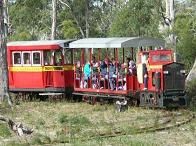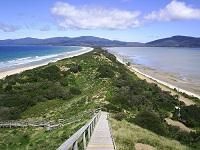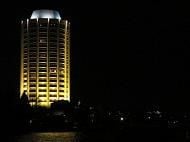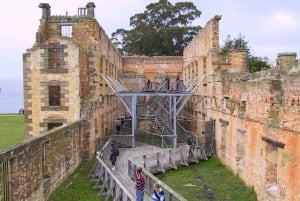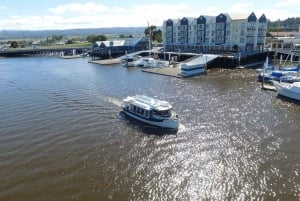Hobart and South East
Hobart
Built into the picturesque framework of smooth mountain slopes and lush riverbanks, Hobart is one of Australia’s most beautiful cities. It is the nation’s most southerly state capital and one of only a few places in the world from which you can cruise to Antarctica. With its friendly, light-hearted locals, its stress-free atmosphere and its stunning natural surroundings, Hobart is a very enjoyable place to relax and explore.
As the second oldest city in Australia, Hobart holds an intriguing history. In 1804, the Lady Nelson reached the shores of Hobart. On board were five families of free settlers, a few colonial rulers and a group of convicts brought here from Sydney for repeated offences. With an astonishing speed, majestic buildings sprang out of the desolate wilderness along the shores of the Derwent River. Today many of the city’s historic buildings can still be seen along Macquarie Street.
You can easily explore the inner city on foot. City life revolves around Hobart’s bustling harbour, which is the site of numerous lively festivals as well as the finishing point of Australia’s popular annual Sydney to Hobart Yacht Race. Along the southern waterfront is Salamanca Place, a row of former warehouses, which have been restored and converted into art galleries, shops, exclusive restaurants and cosy cafés and bars. Behind the buildings is Salamanca Square with more options for dining and – on many summer evenings – live music.
Salamanca Market
From small beginnings of 12 stalls in 1972, the Salamanca Market in Hobart now has over 300 stalls and attracts up to 25 000 people. It has a vibrancy and energy that is delightful and operates in the beautiful setting of Salamanca Place. The outdoor market comes alive every Saturday between the historic Georgian Warehouses and the lawns. In days past, the area was the haunt of sailors, whalers and merchants. The other side of the lawns is Hobart’s waterfront where you’ll find hardworking fishing boats as well as luxury yachts and everything in-between. Salamanca Place is Tasmania’s cultural, creative hub with the sandstone warehouses now filled with artisans, galleries, cafes and restaurants. Only five minutes walk from the CBD, it is a great place to visit on any day, but is transformed on market day.
On the northern end of the harbour, the Maritime Museum of Tasmania provides an insight into Tasmania’s rich nautical history. Walk down historic Macquarie Street to get to the Tasmanian Museum and Art Gallery including a display on Tasmania’s natural history and its indigenous heritage. Among the city’s historic buildings are the Town Hall, the GPO, the Theatre Royal and Parliament House.
The elevated quarter of Battery Point has maintained its old-town charms. This used to be a bustling district with imposing mansions, Victorian cottages, churches and pubs. Many of the old buildings are still standing and have been transformed into antique shops, teahouses or authentic restaurants. From the hilly streets of Battery Point you get good views of Mt Nelson and Mt Wellington as well as onto the Derwent River.
Further south is the scenic suburb of Sandy Bay with its impressive Wrest Point Casino. From the bay you can enjoy splendid views along the river and of the city, making this a popular photo shooting spot.
The suburb of South Hobart is home to the famous Cascade Brewery, which runs tours through its malt-infused premises several times a day.
The spacious Queens Domain runs along the western shores of the Derwent and is only a short stroll from the city centre. The Botanic Garden near the Tasman Bridge is one of the oldest within Australia. This is a great place for a picnic while enjoying Hobart’s moderate pace. The Subantarctic Plant House is home to a series of plants that are native to Macquarie Island, 1500 km south of Tasmania.
On a clear day, both Mt Nelson and Mt Wellington offer splendid views across Hobart and, if you’re lucky, even as far as Bruny Island.
Bruny Island
Within easy reach from Tasmania’s mainland, Bruny Island is a popular holiday retreat for both Tasmanians and foreign visitors. It offers fine beaches, clear water and an abundance of wildlife. From Dennes Point in the north down to Cape Bruny in the south the island only measures around 65 km in length and actually consists of two very different isles that are connected by an isthmus called ‘The Neck’.
North Bruny is a hilly bushland surrounded by pristine beaches. This is where the vehicular ferry from Kettering will drop you off and you’re most likely to start your discovery of Bruny. If you’re planning to stay on the North Island overnight, head to the little township of Dennes Point,which has a good range of accommodation.
The Neck with its crystal white beaches and turquois ocean is a great place to stop and dip your feet into the cool water. The lookouts along The Neck offer superb 360° views across both parts of Bruny Islands. Fairy Penguins make their way up the beach just after sunset and you can watch them waddle to their nests.
South Bruny. With its serene bays and steep cliffs, South Bruny is the most impressive part of Bruny Island. The South Bruny National Park covers a large part of its landmass and protects an abundance of birdlife, wildflowers and tall forests. It also offers some impressive coastal walks. From the Cape Bruny Lighthouse in the far south you get magnificent views to the South Cape of Tasmania, Australia’s most southerly point. The townships of Adventure Bay, Alonnah and Lunawanna are also located on the South Island and offer accommodation as well as restaurants and cafés.
Richmond
The historic country town of Richmond is worth a little detour on your way from Hobart to Port Arthur. With its well-maintained old buildings, churches and the much-photographed stone bridge across the Coal River, Richmond is like an open-air museum reflecting Tasmania’s colonial history.
Many of the old houses are privately owned and still inhabited. Among the public buildings is the Richmond Gaol, which used to provide an overnight shelter for convicts that were brought to Port Arthur from Hobart. The old stone bridge, the post office and general store are among the oldest of their kind in all of Australia.
The Old Hobart Town Model Village is a miniature replica of Hobart in the 1820’s, and it offers a unique insight into the rich colonial past of the area.
Richmond is also home to Zoodoo Wildlife Park which has a large range of native, agricultural and exotic animals including white African Lions and Bengal Tigers
Accommodation options in Richmond range from cosy cottages to luxurious manors.
Tasman Peninsula
The impressive ruins of Port Arthur have made the Tasman Peninsula one of the most popular tourist destinations in Tasmania. Many visitors don’t realize that the old stone relics are framed into a stunning coastal landscape including Australia’s highest cliffs. Take at least two days to explore both the eerie convict history as well as the breathtaking nature of this special place.
Only a narrow strip of land – the Eaglehawk Neck – connects the peninsula to Tasmania’s Southeast; a fact that ignited the idea that this could be an ideal natural prison. From the colonists’ point of view, Hobart was conveniently close, yet practically impossible to reach for the convicts. Armed guards and savage dogs protected the narrow land bridge, while the waters surrounding the peninsula were rumoured to be swarming with sharks. Of those desperate convicts who attempted an escape, almost everyone got caught.
Established in 1830, Port Arthur remained a loathed prison for almost 50 years before the land was sold to free settlers. However, the dark history of the place proved to be too powerful to simply be wiped off with a fresh start. In 1979, the Australian Government acknowledged Port Arthur as an official historic site.
Today, you can visit the Port Arthur Historic Site: the remainders of the old prison and some officer’s cottages embedded into an English parkland. There’s a variety of entry passes available, all include a guided tour and grant access to the premises and into the buildings. Comprehensive information is available at the Visitor Centre.
There’s an abundance of natural attractions on the Tasman Peninsula. This is a great place to put on your hiking shoes and explore the stunning nature. A multi-day hike takes you to the dizzying Cape Pillar, where you find Australia’s highest cliffs at almost 300 metres. For shorter hikes with similarly impressive outlooks take a walk to Cape Huay or Cape Raoul.
And don’t miss the unusual rock formations along the east coast just south of the Eaglehawk Neck: The Tasman Blowhole, Tasman Arch and Devils Kitchen show the powerful impact of wind and weather to this ever-changing coastal scenery.
For an encounter with Tasmania’s flagship marsupial – the Tasmanian Devil – visit the Tasmanian Devil Conservation Park near Taranna.
Along the Huon River
Tasmania’s far south offers a harsh landscape of sharp contrasts. The riverbanks of the Huon are home to a precious rarity, a highly sought-after wood: the old Huon Pine. Some of these trees are over 2000 years old. Tasmania has many skilled artisans who work with Huon pine and other speciality Tasmanian timbers. These include Black-heart Sassafras, Myrtle, Celerytop Pine and Blackwood and can be found in many locations throughout Tasmania.
The area around Huonville is known as Tasmania’s fruit basket: among cherries, pears, plums and berries, the region harvests half of Tasmania’s total apple production . The Huon Peninsula also produces some excellent wines.
Not far from the small town of Geeveston a gate made of swamp gum marks the transit from the cultural landscape with a European flavour to the rough wilderness of the far south. Further west the Tahune Air Walk provides impressive views onto the Tahune State Reserve from a bird’s perspective. Take a short break along Arve Road, which runs through the Reserve, to see attractions such as Keoghs Creek, the Big Tree and the West Creek Lookout.
Further south, the small villages of Dover and Southport are popular holiday destinations that can get busy during school holidays. A short detour takes you to the Hastings Caves and the nearby Thermal Springs, where you can enjoy a relaxing bath in the 28°C waters.
The historic Ida Bay Railway departs from the station at Lune River and meanders through the forest until it reaches Deep Hole Bay with its secluded beach.
A gravel road takes you down to Cockle Creek, Australia’s most southerly point. This is the start of the South Coast Walking Track travelling all the way to Melaleuca near Tasmania’s west coast through a rough and untamed nature.
Photo credits: Salamanca market, Hobart, courtesy Kham Tran www.khamtran.com; Salamanca nightspots, MDT; Wrest Point Casino, MDT; Bruny Island "the neck", MDT; white lions, courtesy Zoodoo; Fur Seals courtesy Neville Coleman; Huon Pine products, MDT; Ida Bay Railway, courtesy Ida Bay Railway


